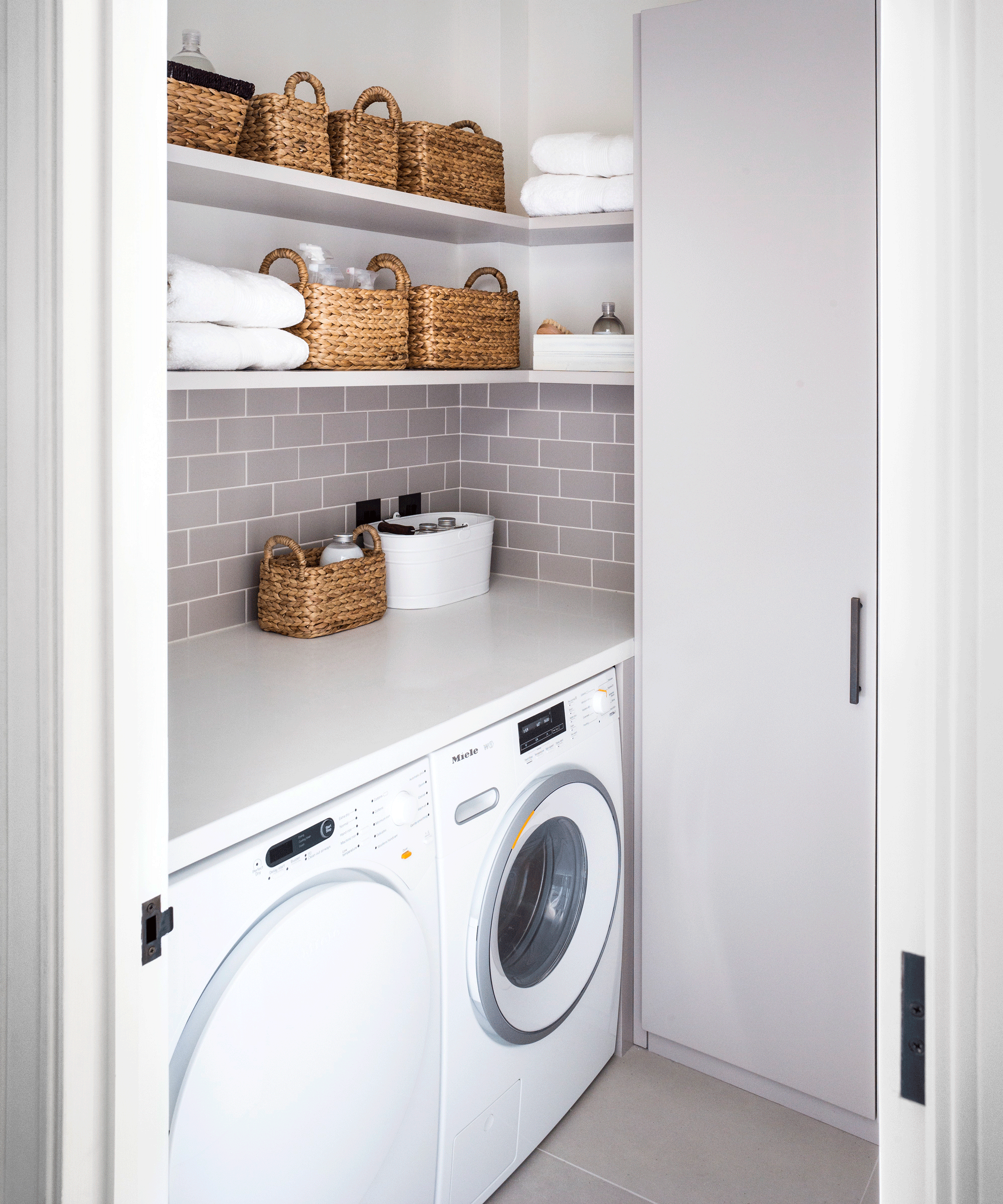
Washing machine settings can be confusing, even if you’ve been doing laundry for many years. Back in the day, a typical washing machine had three settings at most (those of us who have lived in rental accommodation will know that they still exist).
Nowadays, the washing machine settings dial can look like the control panel for a spaceship. So, how do you navigate the increasingly complex washing machine settings on newer washing machines? Which one should be your standard one when doing laundry, and when is it worth experimenting?
We’ve asked laundry experts to shed some light on how to make the most of your washing machine and get the best laundry results by playing around with the settings.
A guide to washing machine settings
There are three basic parameters that make up your washing machine cycle: the water temperature, the agitation intensity, and the spin speed. While the more advanced settings on modern washing machines will let you select both the spin speed and temperature manually, for ease of everyday use, most washing machines have quick-dial settings that let you select a cycle type without having to tinker with manual settings.
Whatever make or model your washing machine, it likely will have the following three basic settings:

1. 'Normal'
The normal cycle is the standard cycle suitable for most mixed clothing loads, towels, and cotton sheets. Typically, the normal cycle is also the longest cycle on your washing machine, lasting anywhere between 45 minutes and 1,5 hours.
However, some washing machines will let you shorten the length of the normal cycle. Some will have a separate manual setting that allows you to make the cycle shorter (look for words like ‘‘quick’’, or ‘‘half time’’); others will let you select between load sizes: if you select the smallest load size, the cycle time will be shorter. Again, this isn’t always possible because some washing machines have built-in sensors that determine the weight of your load and calculate the wash cycle length based on that.
Hyacinth Tucker, laundry expert and CEO of The Laundry Basket, recommends the normal cycle as the default setting for most of your everyday laundry needs: the normal cycle ‘‘ is like your trusty sidekick’’, she says. ‘‘It's perfect for cotton, linen, and most mixed fabrics with moderate soil levels. With warm water and a high spin speed, this cycle ensures a thorough clean without being too harsh on your clothes.’’
It’s still important to properly sort through your clothes rather than just throwing everything together on a normal cycle. Learning how to do laundry is partly about learning what different fabrics need to be kept clean without being excessively worn out by washing.
Every time you wash something, you agitate the fibers in the clothing, which over time leads to pilling, color fading, and even tears. Washing similar items together will reduce the rate at which this happens.
2. Permanent press
The ''permanent press'' cycle was created in the middle of the last century when synthetic fabrics like nylon and polyester came into use. These fabrics tend to wrinkle easily, and the permanent press cycle delivers less agitation during the wash, keeping your items wrinkle-free. This is the perfect cycle for athletic clothing, clothing made from satin (a.k.a. polyester), and polyester-blend sheets. Some people also like using the permanent press cycle for washing their shirts, as this can reduce the need for ironing them.
Remember that the permanent press cycle tends to use warm or lukewarm water, and if your shirts are heavily soiled, you may find that the areas around the armpits and collar won’t be completely clean.
Top tip: On newer washing machines, the permanent press cycle can be marked as a "wrinkle-free" or "easy care" setting.
3. Delicate
The delicate cycle is invaluable if you own anything made from real silk or wool. Hyacinth explains that ‘‘it's a gentle wash with a lower spin speed to protect those delicate fabrics from damage.’’
It is important to check your washing machine manual to determine if the delicate cycle on your washing machine uses warm or cold water. Some fabrics, especially silk and wool blends, shrink very easily, which makes even lukewarm water unsuitable for them. If the default delicate setting uses warm water, you may be able to use the machine's manual controls to switch to cold water. If this isn’t possible, you may just have to handwash your item.

Additional settings
These are the basic settings found on most washing machines. Now, things get more interesting with the many additional setting possibilities on modern washing machines. The most common ones are:
4. Heavy duty
A heavy-duty setting is great news if you regularly wash towels or if you have kids who regularly stain clothing (or if they’re very young and you’re using reusable diapers). Anthony Ekren, laundry expert and the owner at Inherit Clothing, recommends the heavy-duty setting ‘'for heavily soiled items and for tough and sturdy fabrics like denim, towels, and bedding. A stronger agitation cycle is used with the tougher fabric to get it clean, and hot water allows for thorough cleaning.’'
It’s a very good idea to run your bedding on the heavy-duty cycle every six months or whenever you’re about to put your seasonal bedding set away into storage. The hot water in the heavy-duty cycle kills dust mites and germs, which is crucial to keeping your bedding hygienic.
Some new washing machine models will have more specialized heavy-duty cycles. These may have names like ‘‘bright whites’’, ‘‘deep clean’’, or ‘‘sanitize.’’ The deep clean setting typically will use a longer cycle with an additional pre-soak and/or rinse.
The ‘‘sanitize’’ setting will use the hottest water possible (near-boiling) to disinfect items like baby clothes and other soiled items. It’s also a great setting for running an empty maintenance cycle unless your washing machine has a separate one for that.
5. Wool/silk
This essentially is the same setting as the ‘‘delicate’’ setting. If your washing machine has separate wool and silk settings, that's even better, and you should wash your wool and silk items separately if that’s the case.
Silk typically can deal with a little bit more agitation than wool for a thorough clean, while wool benefits from a very gentle cycle that essentially soaks the garment for a while and then gently squeezes it out before a final spin at a very low speed.
6. Quick wash/express
This is a very useful setting for washing just a few things, or when you don’t have the time to wait around for the normal setting to complete. A quick wash cycle is typically around 15-30 minutes long but goes through the same stages as the normal one (intense agitation, rinse, spin).
A quick wash cycle is unsuitable for heavily soiled items, and compensating with more detergent won’t work. Use it for light-to-medium soiled items only.
7. Whites/colors
These settings give you the choice between a hot water and a warm water wash. Bright colors and dark fabrics will fade if washed in hot water, while whites may look dull and gray if washed in insufficiently hot water.
Having said that, many modern washing machine models boast newer technologies that can wash any color fabric in cold water with good results. In this case, you may not need to separate your clothing into different batches.
8. Eco
An eco cycle typically uses less water and/or energy to give you the same result as a normal cycle. Eco cycles tend to be longer than regular or normal cycles. Many newer washing machines use different ways to reduce water and energy consumption, mostly by using sensors to determine how much water needs to be used per load. In that case, your washer is unlikely to have an ‘‘eco’’ setting.
9. Dress shirts
The ‘‘dress shirt’’ cycle is the wrinkle-free/permanent press cycle by another name. It uses a lower spin speed at the end to reduce the need for ironing shirts. If your washing machine doesn’t have this setting, use ‘‘permanent press’’, or a normal cycle with a manually reduced spin speed.

Manual settings: what you need to know
Washing machines have control panels with varying degrees of complexity. Some are designed with ease of use in mind and may just offer you settings for different types of fabrics and/or clothing types. You might see a dial that says things like ‘‘shirts’’, ‘’bedding’’, ‘’baby clothes’’, ‘’sports clothes’’, and so on. These are handy, especially if you’re pressed for time and aren’t keen on fussing with your washing machine settings.
At the same time, any washing machine worth its salt should at least allow you to change the temperature and spin speed of your cycle manually. This is very useful for washing individual garments with very specific requirements (see dress shirts above) or when you have an individual preference. For example, you may just have a preference for lower spin speeds even for everyday items to prolong the lifespan of the fabrics.
So, at a glance, these are your typical temperature settings:
- Hot: Hot water has a temperature of 60°C/140°F and above. Use the hot water setting for washing towels, baby clothes, reusable diapers/hygiene products, bedding, and heavily soiled cottons.
- Warm: Warm water is water that’s anywhere between 30°C/ 86°F and 60°C/140°F. Warm water is suitable for colored/dark cottons and blends, and single-fiber delicates (e.g. 100% wool or silk). If your washing machine lets you set a precise temperature, don’t go above 40°C/ 104°F for delicates.
- Cold: Cold water is under 30°C/ 86°F. It’s suitable for very delicate items (e.g. lace or cashmere), silk and wool blends, and anything with a '‘dry clean only’’ laundry symbol if you want to take the risk and wash it anyway. Newer washing machines can also use cold water for regular cycles.
Once you’ve set your temperature, set your spin speed:
- High: A high spin speed is over 1,000 revolutions per minute (RPM). A standard-cycle spin speed is typically set at between 1,200 and 1,400 rpm, but if you have lots of heavy items you don’t want to dry for too long, you may be able to set your spin speed at as high as 1,600 rpm.
- Medium: medium spin speeds of between 600 and 1,000 rpm are good for synthetics and lighter items. A lower spin speed is also useful if you prefer air drying your clothes.
- Low: Low spin speeds of 600 rpm and lower are perfect for wool and silk. A lower spin speed prevents excessive wrinkling, shape loss, and tears.
FAQs
What’s the best setting for washing denim?
Hyacinth Tucker recommends using the permanent press or ‘‘wrinkle-free’’ setting for washing your jeans and other items made from denim. ‘This cycle is specifically designed to minimize wrinkles and creases, which is perfect for denim fabrics,' she says.
What’s the best setting for washing work clothes?
As Anthony Ekren points out, ‘the right setting for your work clothes depends heavily on your fabric and soil level.’ For sturdy fabrics like cotton and polyester, Anthony recommends the normal setting. ‘However, if you wear delicate clothes or if your clothes are heavily soiled and have a tougher fabric content, then you can adjust to a delicate or heavy setting.’
Hyacinth adds that if your work clothes tend to get heavily stained, ‘pre-treating any stubborn stains before tossing your work clothes into the washer is a good idea.’ While your washing machine may have a pre-soak setting, it will be more effective when used together with a good stain remover.
Armed with this essential knowledge about washing machine settings, you'll become a laundry pro in no time!







